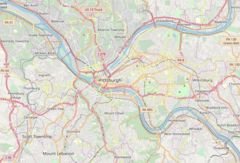Pittsburgh City-County Building facts for kids
 |
|
| Location | 414 Grant Street (Downtown), Pittsburgh, Pennsylvania, USA |
|---|---|
| Coordinates | 40°26′18.12″N 79°59′49.73″W / 40.4383667°N 79.9971472°W |
| Area | Downtown |
| Built/founded | 1914-1917 |
| Architect | Henry Hornbostel |
| Governing body/ |
The City of Pittsburgh & Allegheny County |
The Pittsburgh City-County Building is the main building for the government of Pittsburgh. It holds offices for both the City of Pittsburgh and Allegheny County. You can find it in Downtown Pittsburgh at 414 Grant Street, Pittsburgh, Pennsylvania.
This important building was constructed between 1915 and 1917. It is the third main government building Pittsburgh has had. Today, most of the offices inside belong to the City of Pittsburgh. Allegheny County offices are mostly in nearby buildings. The building also has a courtroom for the Supreme Court of Pennsylvania when they hold meetings in Pittsburgh.
Contents
Why Pittsburgh Needed a New Building
At the start of the 1900s, leaders in Pittsburgh and Allegheny County realized their old government building was too small. The city was growing very fast! Their offices were in the Smithfield Street City Hall, built in the late 1860s.
The need for more space grew a lot when Allegheny City became part of Pittsburgh in 1907. This added 130,000 new people to the city. So, in 1909, plans for a new City Hall began.
Planning and Building the New Home
Mayor William A. McGee suggested selling the old city offices. He wanted to use that money to buy the Allegheny County Courthouse land for a new building. By 1912, both the City of Pittsburgh and Allegheny County agreed to work together. They would buy the land and share the new building.
They held a competition to pick the architect for the new building. Only architects from Allegheny County could enter. The city also wanted to use local materials and workers. In 1914, Mayor Joseph Armstrong said all building materials should come from Pittsburgh companies. He also wanted all workers to be from Allegheny County.
There was a small delay in construction because of a legal disagreement. But the problem was solved, and building could continue.
Breaking Ground and Finishing Up
The groundbreaking ceremony happened on July 6, 1915. County Commissioner I. K. Campbell used a pick to start, and Joseph G. Armstrong Jr. lifted the first shovel of dirt. These tools were later silver-plated and kept as special memories.
A special ceremony for laying the cornerstones happened on March 26, 1916. This was part of Pittsburgh's 100th birthday celebration! A parade ended at the steel frame of the new building. Three cornerstones were laid: one for the City, one for the County, and one for the workers. Each cornerstone held a time capsule with items from that time.
Construction finished in 1917, and it was even completed under budget! In April 1917, the City Law Department was the first to move in. By June, all the other offices had moved into their new spaces. In 2016, the building was suggested to become a City Historic Site.
Cool Design and Features
In 1914, a competition was held to design the new Pittsburgh City Hall. Edward B. Lee, a respected Pittsburgh architect, won. Henry Hornbostel then completed the final design.
Architectural Style
The building was designed in the Beaux Arts style. This is a grand and formal style, often used for important public buildings. It also has ideas from the City Beautiful Movement. This movement focused on making cities beautiful with large, impressive buildings and clean designs. The City-County Building was one of Pittsburgh's first tries at using the City Beautiful Movement in its design.
Henry Hornbostel was known for his unique take on the Beaux Arts style. He often added elements from other styles, sometimes even industrial looks.
Inside the Building
Some of the most interesting parts of the building's design include the Grand Lobby. This is a large, open area with natural light. It has a high, rounded ceiling that is 47 feet tall! Bronze columns hold up the ceiling. These columns were made by Louis Tiffany Studios. At their bases, you can see the Seals of Pittsburgh and Allegheny County. There are also images of frontiersman Guyasuta and Pittsburgh's oldest building, the Fort Pitt Blockhouse.
The fancy elevator doors in the lobby have carvings that show the city's previous government buildings. These carvings show the buildings growing up, becoming adults with the current City-County Building and Allegheny County Courthouse.
What's also special is that much of the furniture was designed by the architect, Hornbostel. The Mayor's Office, the Council Chamber, and the Supreme Court Room still use furniture from 1917 today!
On the seventh floor, there is a huge painting called "Justice." It was finished in 1940 by the famous artist Harry Scheuch.
Gallery
Fun Facts
- The downtown branch of the Carnegie Library of Pittsburgh was located in this building until November 1930.







